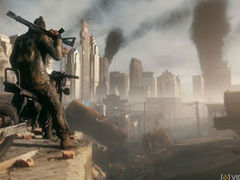Video Gamer is reader-supported. When you buy through links on our site, we may earn an affiliate commission. Prices subject to change. Learn more
Take a look at last week’s gameplay demo of Homefront: The Revolution and you’ll probably spot a fair few resemblances to Ubisoft’s Far Cry series.
But while Deep Silver Dambuster acknowledges that there may be some elements to Homefront that Far Cry players “find familiar”, it also claims there are things that “set it apart in a different way”.
“Obviously this is just a small section of the open world,” game designer Fasahat Salim told VideoGamer.com last week while discussing the game’s similarity to Far Cry. “It’s obviously not set in a jungle. This is urban warfare, and for us it was very important to actually capture the essence of what it means to be a resistance fighter and get that vibe of guerilla warfare.
“That was the main pillar of what we were trying to achieve, so everything we’ve done is focussed around trying to portray guerilla warfare and what it means to be a guerilla fighter. That means that you can’t use just whatever gun you have and run straight into a combat situation because you will get mowed down. You have to think about how to take on an enemy when they are least expecting it, hit them, get what you need and get out. You are the underdog in this. You are not the guy with the big guns. You need to hit them and get out before they bring their big guns. So for us that is one of the most important things.”
One of the comparisons to Far Cry has centred around Homefront’s new Strike Points, enemy-held positions similar to Far Cry’s Outposts that can be taken over to increase resistance presence in the area. Once they’ve been taken control of, the camera will even swoop around local points of interest, similar to reaching the top of Far Cry’s radio towers.
“Each Strike Point will reveal a certain part of the map and give you more of a resistance presence in that space,” Salim continues. “However, one of the things that does set our system apart is, when you take these Strike Points it doesn’t clear the area of enemies. It doesn’t complete the gameplay that was set out. We want to keep that space functioning so if the player moves back there they’re still going to find content to do, there’s still going to be interactions for them to carry out, whereas say in Far Cry, if you take a piece of content and complete it that space is done. You’ve pretty much got no reason to return there. We wanted to make sure the KPA are still very much there because they are the occupiers. They’re ruling with an iron fist. Just because a bunch of resistance are causing problems doesn’t mean they’re just going to vanish.
“The idea is that when you’ve done a Strike Point, you have resistance guys taking cover behind buildings, you have guys at vantage points, you’ll see guys maybe running along somewhere,” he continues. “And the interesting thing is, if you follow any resistance guy that you come across in the street, they’re actually going to do their own resistance mission.
“So they’re there for a reason. You’re not the only guy doing your resistance mission. Everyone else in that space is now part of this revolution. If you follow them they’ll lead you into whatever objective or mission they were carrying out. So for us, that’s quite a big distinction to some of the other [games] because the player could primarily come across or stumble across content that they weren’t even intending on doing, stuff that might change the way that they approach a specific mission that they had planned anyway.”
The game is also being built around emergent, systemic gameplay, Salim adds, which can dynamically alter the way in which the player approaches missions.
“The idea is that if you approach a mission and, say, the emergent system decides to create a skirmish between a bunch of resistance fighters and some KPA just down the road, that skirmish could actually draw in some of the patrols that were blocking the route to your objective. So all of a sudden you might have an easier, clearer way into whatever mission you were doing. Or it could work against you. Maybe something happens on the other side and more people are pulled into your objective. So that changes the dynamics of how you approach missions and these are things that us as developers don’t have control over.
“Sure, we can come up with specific types of missions for the player to carry out but we don’t know what’s going to happen minute-to-minute on the ground and each of those things changes the dynamic of how you want to approach something. So that is basically one of the main things that we’ve been trying to aim for and that was something that came about when we decided to go down an open world route.”
Homefront: The Revolution launches on Xbox One, PS4 and PC in 2016.

/https://oimg.videogamer.com/images/9e19/homefront_the_revolution_9.jpg)